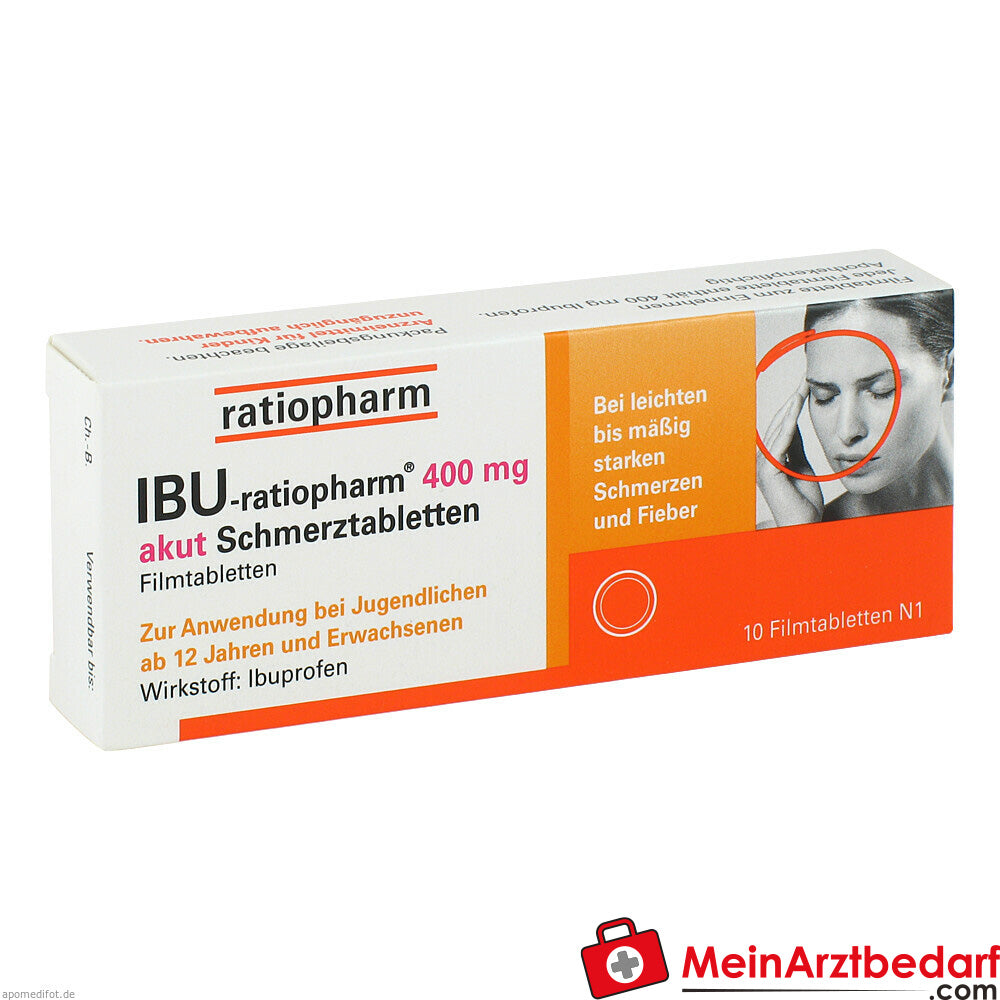IBU-ratiopharm Ibuprofen 400 mg Schmerztabletten
Marke: ratiopharm GmbH
Zu Risiken und Nebenwirkungen lesen Sie die Packungsbeilage und fragen Sie Ihre Ärztin, Ihren Arzt oder in Ihrer Apotheke. (Pflichttext)
Verkauf & Versand durch: Lahn-Apotheke Marburg
Lieferumfang
Lieferumfang: 1 Packung IBU-ratiopharm Ibuprofen 400 mg Schmerztabletten (Tabletten) in der gewählten Packungsgröße – Hersteller: ratiopharm.
Produktdetails & Pflichtangaben
IBU-ratiopharm 400 akut Schmerztabletten im Detail
Die Gesamtdosis sollte nicht ohne Rücksprache mit einem Arzt oder Apotheker überschritten werden.Art der Anwendung?
Nehmen Sie das Arzneimittel mit Flüssigkeit (z.B. 1 Glas Wasser) ein.
Dauer der Anwendung?
Ohne ärztlichen Rat sollten Erwachsene das Arzneimittel nicht länger als 3 Tage bei Fieber bzw. für mehr als 4 Tage bei Schmerzen anwenden. Kinder und Jugendliche sollten das Arzneimittel ohne ärztlichen Rat nicht länger als 3 Tage anwenden. Wenn sich die Symptome verschlimmern sollte generell ärztlicher Rat eingeholt werden.
öberdosierung?
Bei einer öberdosierung kann es unter anderem zu Kopfschmerzen, Schwindel, Bauchschmerzen, öbelkeit, Erbrechen, Blutdruckabfall, Benommenheit sowie zu Atemstörungen kommen. Setzen Sie sich bei dem Verdacht auf eine öberdosierung umgehend mit einem Arzt in Verbindung.
Einnahme vergessen?
Setzen Sie die Einnahme zum nächsten vorgeschriebenen Zeitpunkt ganz normal (also nicht mit der doppelten Menge) fort.
Generell gilt: Achten Sie vor allem bei Säuglingen, Kleinkindern und älteren Menschen auf eine gewissenhafte Dosierung. Im Zweifelsfalle fragen Sie Ihren Arzt oder Apotheker nach etwaigen Auswirkungen oder Vorsichtsmassnahmen.
Eine vom Arzt verordnete Dosierung kann von den Angaben der Packungsbeilage abweichen. Da der Arzt sie individuell abstimmt, sollten Sie das Arzneimittel daher nach seinen Anweisungen anwenden.Aufbewahrung
Das Arzneimittel darf nach Anbruch/Zubereitung höchstens 2 Jahre verwendet werden!
Das Arzneimittel muss nach Anbruch/Zubereitung bei Raumtemperatur aufbewahrt werden!
Diese Angabe gilt nur für die Tabletten in der Tabletten-Box. Für Tabletten in anderen Verpackungen gilt das aufgedruckte Verfalldatum.Was spricht gegen eine Anwendung?
Immer:
- öberempfindlichkeit gegen die Inhaltsstoffe
- Blutbildungsstörungen
- Geschwüre im Verdauungstrakt, auch in der Vorgeschichte
- Blutungen im Magen-Darm-Trakt, auch in der Vorgeschichte
- Aktive Blutungen, wie:
- Hirnblutungen
- Stark eingeschränkte Leberfunktion
- Stark eingeschränkte Nierenfunktion
- Schwere Herzschwäche
- Schwerer Flüssigkeitsmangel
Unter Umständen - sprechen Sie hierzu mit Ihrem Arzt oder Apotheker:
- Magen-Darm-Beschwerden
- Entzündliche Darmerkrankungen, auch in der Vorgeschichte, wie:
- Morbus Crohn
- Colitis ulcerosa
- Blutgerinnungsstörung
- Bluthochdruck
- Koronare Herzkrankheit (Durchblutungsstörungen des Herzmuskels)
- Mögliche Gefahr einer Gefässverengung am Herzen, wie bei:
- Erhöhte Fettkonzentration im Blut
- Diabetes mellitus (Zuckerkrankheit)
- Rauchen
- Durchblutungsstörungen der Peripherie (z.B. Arme, Beine)
- Durchblutungsstörung der Hirngefässe
- Kollagenosen (Veränderungen im Bindegewebsbereich), wie:
- Lupus erythematodes
- Mischkollagenose (entzündlich-rheumatische Kollagenose)
- Porphyrie (Stoffwechselkrankheit)
- Grössere Operation, die kurz zuvor stattgefunden haben
- Windpocken
Welche Altersgruppe ist zu beachten?
- Kinder unter 6 Jahren: Das Arzneimittel sollte in dieser Gruppe in der Regel nicht angewendet werden. Es gibt Präparate, die von der Wirkstoffstärke und/oder Darreichungsform besser geeignet sind.
- éltere Patienten ab 65 Jahren: Die Behandlung sollte mit Ihrem Arzt gut abgestimmt und sorgfältig überwacht werden, z.B. durch engmaschige Kontrollen. Die erwünschten Wirkungen und unerwünschten Nebenwirkungen des Arzneimittels können in dieser Gruppe verstärkt oder abgeschwächt auftreten.
Was ist mit Schwangerschaft und Stillzeit?
- Schwangerschaft: Wenden Sie sich an Ihren Arzt. Es spielen verschiedene öberlegungen eine Rolle, ob und wie das Arzneimittel in der Schwangerschaft angewendet werden kann.
- Stillzeit: Wenden Sie sich an Ihren Arzt oder Apotheker. Er wird Ihre besondere Ausgangslage prüfen und Sie entsprechend beraten, ob und wie Sie mit dem Stillen weitermachen können.
Ist Ihnen das Arzneimittel trotz einer Gegenanzeige verordnet worden, sprechen Sie mit Ihrem Arzt oder Apotheker. Der therapeutische Nutzen kann höher sein, als das Risiko, das die Anwendung bei einer Gegenanzeige in sich birgt.Welche unerwünschten Wirkungen können auftreten?
- Magen-Darm-Beschwerden, wie:
- öbelkeit
- Erbrechen
- Sodbrennen
- Blähungen
- Durchfälle
- Verstopfung
- Bauchschmerzen
- Blutungen im Magen-Darm-Bereich
- Teerstühle, bei Auftreten bitte sofort einen Arzt aufsuchen
- Magenschleimhautentzündung
- Geschwüre im Verdauungstrakt, die sehr selten auch durchbrechen können
- Kopfschmerzen
- Schwindel
- Schlaflosigkeit
- Müdigkeit
- Reizbarkeit
- Erregung
- öberempfindlichkeitsreaktionen der Haut, wie:
- Hautausschlag
- Juckreiz
- Anfälle von Atemnot
- Sehstörungen, bei Auftreten bitte sofort einen Arzt aufsuchen
Bemerken Sie eine Befindlichkeitsstörung oder Veränderung während der Behandlung, wenden Sie sich an Ihren Arzt oder Apotheker.
Für die Information an dieser Stelle werden vor allem Nebenwirkungen berücksichtigt, die bei mindestens einem von 1.000 behandelten Patienten auftreten.Was sollten Sie beachten?
- Das Reaktionsvermögen kann auch bei bestimmungsgemässem Gebrauch, vor allem in höheren Dosierungen oder in Kombination mit Alkohol, beeinträchtigt sein. Achten Sie vor allem darauf, wenn Sie am Strassenverkehr teilnehmen oder Maschinen (auch im Haushalt) bedienen, mit denen Sie sich verletzen können.
- Bei Schmerzen oder Fieber ohne ärztlichen Rat nicht länger anwenden als in der Packungsbeilage vorgegeben!
- Bei dauerhafter Anwendung von Schmerzmitteln können Kopfschmerzen auftreten, die durch das Schmerzmittel erzeugt werden. Sprechen Sie mit Ihrem Arzt, um zu verhindern, dass Ihre Kopfschmerzen chronisch werden.
- Die gewohnheitsmässige Anwendung von Schmerzmitteln kann zu einer dauerhaften Nierenschädigung führen. Werden mehrere Schmerzmittel kombiniert, oder sind in einem Schmerzmittel mehrere Wirkstoffe enthalten, erhöht sich das Risiko dafür.
- Vorsicht: Patienten mit Nasenpolypen, chronischen Atemwegsinfektionen, Asthma oder mit Neigung zu allergischen Reaktionen wie z.B. Heuschnupfen: Bei Ihnen kann das Arzneimittel einen Asthmaanfall oder eine starke allergische Hautreaktion auslösen. Fragen Sie daher vor der Anwendung Ihren Arzt.
- Vorsicht bei Allergie gegen Schmerzmittel!
- Vorsicht bei Allergie gegen Bindemittel (z.B. Carboxymethylcellulose mit der E-Nummer E 466)!
- Es kann Arzneimittel geben, mit denen Wechselwirkungen auftreten. Sie sollten deswegen generell vor der Behandlung mit einem neuen Arzneimittel jedes andere, das Sie bereits anwenden, dem Arzt oder Apotheker angeben. Das gilt auch für Arzneimittel, die Sie selbst kaufen, nur gelegentlich anwenden oder deren Anwendung schon einige Zeit zurückliegt.
- Alkoholgenuss soll während einer Dauerbehandlung möglichst vermieden werden. Gelegentlicher Alkoholkonsum in kleinen Mengen ist erlaubt, aber nicht zusammen mit dem Medikament.
Wie wirkt der Inhaltsstoff des Arzneimittels?
Der Wirkstoff gehört zu einer Gruppe von Stoffen, die sowohl gegen Schmerzen, als auch gegen Entzündungen wirken und Fieber senken können. Alle drei Wirkungen beruhen vor allem auf der Hemmung eines körpereigenen Stoffes, genannt Prostaglandin. Dieser Stoff muss als Botenstoff vorhanden sein, damit Schmerz empfunden, Entzündungsreaktionen gestartet oder die Körpertemperatur angehoben werden kann.
Anwendung
- Leichte bis mässig starke Schmerzen, wie:Dosierung
Allgemeine Dosierungsempfehlung:1/2 Tablette1-3 mal täglichKinder von 6-9 Jahren(mit 20-29 kg Körpergewicht)im Abstand von 6 Stunden, zu der Mahlzeit1/2 Tablette1-4 mal täglichKinder von 10-11 Jahren
(mit 30-39 kg Körpergewicht)im Abstand von 6 Stunden, zu der Mahlzeit1/2-1 Tablette1-4 mal täglich
(max. 3 Tabletten pro Tag)Jugendliche ab 12 Jahren und Erwachsene
(über 40 kg Körpergewicht)im Abstand von 6 Stunden, zu der MahlzeitBei einem empfindlichen Magen empfiehlt es sich das Arzneimittel während der Mahlzeit einzunehmen.
Wichtige Hinweise
Zu Risiken und Nebenwirkungen lesen Sie die Packungsbeilage und fragen Sie Ihre Ärztin, Ihren Arzt oder in Ihrer Apotheke.
Der Verkäufer behält sich vor, eine pharmazeutische Kontrolle durch unsere Apotheker über die bestellte Menge des Medikamentes durchzuführen. Hierbei kann es zu Kürzungen bei Ihrer Bestellung zu diesem Produkt kommen. Der Rechnungsbetrag wird dann automatisch angepasst.
Der Grund dafür ist unsere pharmazeutische Sorgfaltspflicht.
Bei Schmerzen oder Fieber ohne ärztlichen Rat nicht länger anwenden als in der Packungsbeilage vorgegeben!
Ohne ärztlichen Rat nicht länger anwenden als in der Packungsbeilage vorgegeben!

Über MeinArztbedarf.com
Unser Onlineshop wird von der Mein Arztbedarf GmbH mit Sitz in Hall in Tirol, Österreich betrieben. Wir sind spezialisiert auf medizinischen Fachbedarf, Diagnostik, Beatmungsmedizin und Arzneimittel.
An wen richtet sich das Angebot?
Unser Angebot richtet sich an medizinisches Fachpersonal, Institutionen und Privatpersonen.
Ist die Bestellung sicher?
Ja! Wir nutzen eine verschlüsselte Verbindung (SSL) und arbeiten ausschließlich mit zertifizierten Zahlungsanbietern.
Welche Zahlungsmethoden gibt es?
Wir bieten u. a. Kreditkarte, PayPal, Klarna, Sofortüberweisung, Vorkasse und Kauf auf Rechnung.
Wie lange dauert der Versand?
In der Regel erfolgt der Versand innerhalb von 1–3 Werktagen, sofern die Ware lagernd ist. Genaueres finden Sie direkt beim Produkt.
In welche Länder wird geliefert?
Wir liefern derzeit nach Österreich, Deutschland, Italien, Frankreich, Polen, Spanien und in die Niederlande.
Kann ich Produkte zurückgeben?
Ungeöffnete und unbenutzte Produkte können Sie innerhalb von 14 Tagen zurückgeben – außer es handelt sich um Hygiene- oder Arzneimittel. Siehe dazu den Widerruf.
Gibt es Mengenrabatte oder individuelle Angebote?
Ja! Für größere Bestellungen oder Einrichtungen erstellen wir gerne ein individuelles Angebot. Kontaktieren Sie uns!
















